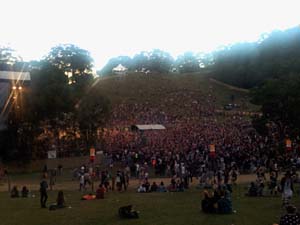Telstra retreat hands Vodafone Splendour mobile coverage win

Decisions made by Optus and Telstra to only send 3G cells on wheels to this year's Splendour in the Grass meant that internet was inaccessible from the fields of the Splendour in the Grass music festival in Byron Bay last weekend.
The festival attracted more than 30,000 visitors across Friday, Saturday, and Sunday to grounds around half an hour north of Byron Bay on the far north coast of New South Wales.
In Byron Bay itself, Telstra, Optus, and Vodafone all provide 4G coverage to the town, with similar speed test results ranging between 17Mbps to 24Mbps in download speeds, but due to the festival's location 22km north of the town, coverage is sparse, with no dedicated towers there. The rest of the year the population is but a fraction of that during the festival, making it uneconomical for mobile carriers to build permanent towers at the site.
Splendour in the Grass organisers themselves use two microwave backhaul links to the site for all communication, radio transmission, and internet access in and out of the festival, and while free Wi-Fi was provided this year by streaming music company Spotify, demand for mobile coverage to the site remains high.
Telstra last year was the carrier of choice for the festival, with two 4G cell-on-wheels (COWs) deployed to the site to provide coverage in the otherwise tower-free festival location.
But this year, Telstra initially withdrew plans to provide a 4G COW free of charge, and instead asked Splendour in the Grass organisers to pay for the coverage over the three days. When the organisers refused, Telstra indicated it wouldn't provide coverage to the Splendour in the Grass site.
Following media reporting of Telstra's decision, the company instead said it would provide two 3G COWs to the site with satellite backhaul.
Telstra offers the largest mobile network coverage across Australia and has the most customers of the three mobile telcos, but opting for 3G over 4G at the festival meant that due to the high number of Telstra customers at the event, the network was virtually unusable for data access across the three days. Some punters reported being able to make phone calls and text, but were unable to access the internet, and upload photos or videos.
"I pay a premium for this," one frustrated Telstra customer told ZDNet.
Optus also struggled, and while the company deployed a COW and had a relay tower close to the site, it too was only 3G access.
The shock to many at the event was the surprise victory for Vodafone over both Optus and Telstra.
Vodafone has struggled to break the perception that its network isn't up to the task. Vodafone has suffered massive customer losses over the past three years on the back of capacity issues in its 3G network in 2010, but since then the company has invested over a billion dollars in rolling out thousands of new 3G and 4G sites across the country.
While Vodafone has 4G coverage in the Byron Bay area, for Splendour in the Grass, Vodafone deployed a 4G COW to the Splendour in the Grass site, meaning that data access across the three days remained constant, with very few issues.
Some joked that it was due to the company's low customer numbers, which sit at lower than 5 million Vodafone-only customers, compared to 9 million and 15 million for Optus and Telstra, respectively.
Earlier this month Telstra said it was exploring a more permanent solution for the Splendour in the Grass festival.
